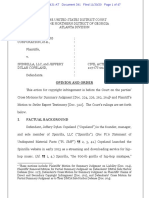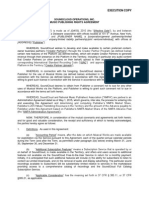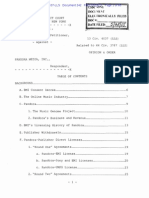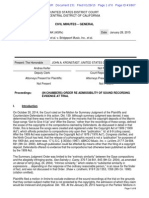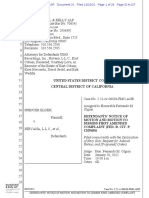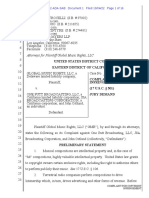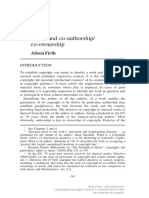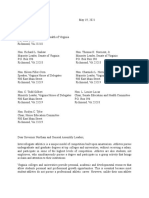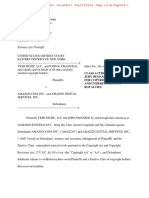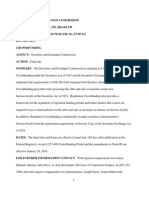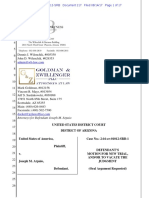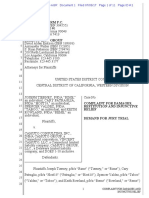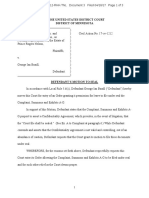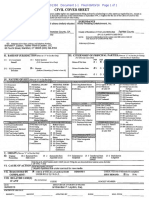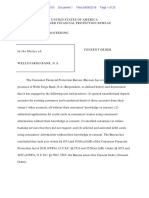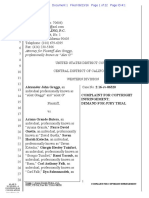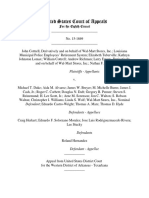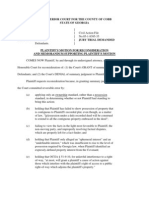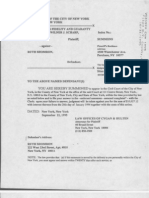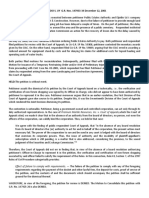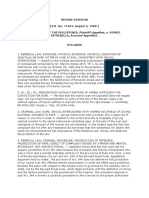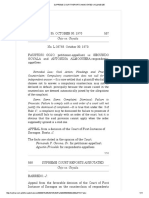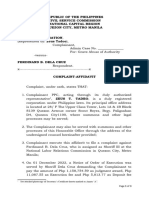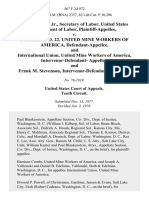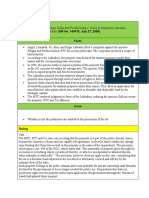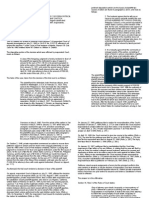Yesh Music v. S Carter Enterprises - Class Action Complaint Royalties TIDAL PDF
Yesh Music v. S Carter Enterprises - Class Action Complaint Royalties TIDAL PDF
Uploaded by
Mark JaffeCopyright:
Available Formats
Yesh Music v. S Carter Enterprises - Class Action Complaint Royalties TIDAL PDF
Yesh Music v. S Carter Enterprises - Class Action Complaint Royalties TIDAL PDF
Uploaded by
Mark JaffeOriginal Title
Copyright
Available Formats
Share this document
Did you find this document useful?
Is this content inappropriate?
Copyright:
Available Formats
Yesh Music v. S Carter Enterprises - Class Action Complaint Royalties TIDAL PDF
Yesh Music v. S Carter Enterprises - Class Action Complaint Royalties TIDAL PDF
Uploaded by
Mark JaffeCopyright:
Available Formats
Case 1:16-cv-01521 Document 1 Filed 02/27/16 Page 1 of 41
Richard M. Garbarini (RG 5496)
GARBARINI FITZGERALD P.C.
250 Park Avenue
7th Floor
New York, New York 10177
Telephone: (212) 300-5358
Facsimile: (347) 218-9478
Attorneys for Plaintiffs
UNITED STATES DISTRICT COURT
EASTERN DISTRICT OF NEW YORK
---------------------------------------------------------------x
YESH MUSIC, LLC, and JOHN K. EMANUELE,
individually and on behalf of all other similarly
situated copyright holders,
Plaintiffs,
v.
Index No.: 16-cv-1521
CLASS ACTION COMPLAINT AND
JURY DEMAND FOR DAMAGES
FOR COPYRIGHT INFRINGEMENT
AND UNDERPAYMENT OF
ROYALTIES
S. CARTER ENTERPRISES, LLC, BLACK
PANTHER BIDCO, LTD, and ASPIRO AB,
Defendants.
--------------------------------------------------------------x
Plaintiffs YESH MUSIC, LLC and JOHN EMANELE, by and through their attorneys at
GARBARINI FITZGERALD P.C., bring this Class Action Complaint and Jury Demand against
Defendants S. CARTER ENTERPRISES, LLC, BLACK PANTHER BIDCO, LTD., and
ASPIRO AB based on the systematic infringement of Plaintiffs and the Putative Class
copyrighted musical Compositions pursuant to the Copyright Act and Copyright Revisions Act,
17 U.S.C. 101 et seq. (the Copyright Act or Act), and Defendants material breach of the
calculation of the compulsory royalty rates owed Plaintiffs and the Putative Class of copyright
holders that received royalties.
Case 1:16-cv-01521 Document 1 Filed 02/27/16 Page 2 of 41
NATURE OF THE ACTION
1.
Defendant ASPIRO is a media technology company that owns and operates
interactive subscription music streaming services TIDAL and WiMP. WiMP started in 2011,
and TIDAL was introduced in 2014. (The TIDAL and WiMP services are referred to here
collectively as the TIDAL Music Service or TIDAL Service.)
2.
In the first quarter of 2015, Defendant ASPIRO was sold to Defendant BLACK
PANTHER BIDCO, LTD. (BIDCO), which is a holding company owned by Defendant S.
CARTER ENTERPRISES, LLC (CARTER). The primary stake holder, Shawn Jay-Z
Carter, made it very clear that he would directly be involved in taking the Tidal Service in a new
direction at re-launch.
3.
The TIDAL Music service is subject to 115 of Title 17 of the United States
Code. As such, Defendants were required to serve a Notice of Intent to Obtain Compulsory
License (NOI), in the form proscribed by 37 CFR 201.18, within thirty (30) days from the
date each copyrighted musical composition was included on its service.
4.
Plaintiffs are the beneficial rights holders to one hundred and eighteen (118)
copyright registrations covering one hundred and forty eight (148) musical recordings which
Defendants have reproduced and distributed through the TIDAL Music Service without a
license.
5.
Plaintiff YESH did not receive any NOIs from TIDAL, but did receive 4 facially
invalid NOIs in 2014 from WiMP. The NOIs were invalid because the recordings identified in
Case 1:16-cv-01521 Document 1 Filed 02/27/16 Page 3 of 41
the NOIs had been on the WiMP service for between one and three years prior to the date of
service. The NOIs also stated an incorrect start date, and all have lapsed without renewal.
6.
Plaintiff EMANUELE has not received an NOI or been paid royalties from either
the WiMP or TIDAL streaming services.
7.
Plaintiff YESH has not received mechanical royalties from the WiMP streaming
service, and only reduced royalties from the TIDAL streaming service.
8.
Ironically, when Defendant CARTER purchased the TIDAL Music Service in
2015, it claimed it would be the first streaming service to pay the artists. Different owner, same
game.
9.
This action is brought by Plaintiffs, on behalf of themselves, and the numerous
other similarly-situated holders of the publishing rights, referred to as the mechanical rights, in
copyrighted musical Compositions which Defendants reproduced and distributed without a
mechanical license, service of an NOI, and/or payment of royalties. Defendants systematic
failure to obtain mechanical licenses is part of an egregious, calculated, and ongoing campaign of
deliberate copyright infringement. This action also seeks to address Defendants material breach
of the calculation of the compulsory royalty rates owed Plaintiffs and the Putative Class of
copyright holders that received royalties.
10.
The forgoing is part of Defendants calculated business plan to avoid he costs
associated with properly serving NOIs, and to retain royalties for which they have no right.
Defendants are liable for their intentional infringement of each of the one hundred and eighteen
Case 1:16-cv-01521 Document 1 Filed 02/27/16 Page 4 of 41
(118) registrations in the amount of $150,000 per registration, but in no case less than $30,000
per registration and/or Defendants profits, attorneys fees, and costs.
PARTIES
11.
At all times material hereto, Plaintiff Yesh Music, LLC (YESH) was, and is, a
limited liability company organized under the laws of the State of New York, with its principal
offices located at 75-10 197th Street, Flushing, New York. YESH is engaged in, among other
things, the business of music publishing and otherwise commercially exploiting its copyrighted
sound recordings of the band The American Dollar. The sole members of Plaintiff are Richard
Cupolo and John Emanuele, who are also the sole composers of the Copyrighted Compositions.
12.
At all times material hereto, Plaintiff John K. Emanuele (EMANUELE) was,
and is, an individual and resident of Queens. EMANUELE released two collections of songs
under the name Zero Bedroom Apartment, which Defendant elected to exploit. EMANUELE
received neither an NOI, royalty, nor statement of account.
13.
Plaintiffs are informed and believe, and on that basis aver, that Defendant S.
Carter Enterprises, LLC (CARTER) is a New York limited liability company with a
headquarters located at 1411 Broadway, 39th Floor. New York, NY 10018. CARTER may be
served through C/O CORPORATE CREATIONS NETCOMPOSITION INC., 15 North Mill
Street, Nyack, NY, 10960.
14.
Plaintiffs are informed and believe, and on that basis aver, that BLACK
PANTHER BIDCO LTD (PANTER) is a shell company with a headquarters located at 1411
Case 1:16-cv-01521 Document 1 Filed 02/27/16 Page 5 of 41
Broadway, 39th Floor. New York, NY 10018. CARTER may be served through C/O
CORPORATE CREATIONS NETCOMPOSITION INC., 15 North Mill Street, Nyack, NY,
10960.
15.
Defendant Aspiro AB (ASPIRO) is a Norwegian/Swedish company that is
currently a wholly owned BIDCO which is a wholly owned subsidiary Defendant CARTER.
When CARTER purchased ASPIRO (through BIIDCO) in 2015, Defendant CARTER made it
clear that it would be controlling the operations of the TIDAL Music Service.
JURISDICTION AND VENUE
16.
The jurisdiction of this Court is based upon 28 U.S.C. 1331 and 1338 in that
this controversy arises under the Copyright Act and Copyright Revision Act of 1976 (17 U.S.C.
101 et seq.). This action is a civil action over which this court has original jurisdiction.
17.
Jurisdiction also exists pursuant to 28 U.S.C. 1332(d)(2) because the matter in
controversy exceeds the sum or value of $5,000,000 (exclusive of interest and costs), is a class
action in which a member of the proposed class, including Plaintiff, is a citizen of a state
different from Defendants, and the number of members of the proposed class exceeds 100.
18.
On information and belief, a substantial part of the facts of infringement
complained of herein occurs or has occurred in this District, and Defendant is subject to personal
jurisdiction in this District.
19.
Personal jurisdiction over Defendant CARTER is proper in this Court, among
other reasons, on the grounds that CARTER through its interactive web-based subscription
service which caused the unlicensed distribution of the Copyrighted Compositions throughout
Case 1:16-cv-01521 Document 1 Filed 02/27/16 Page 6 of 41
the State of New York, including within this Judicial District. CARTER also maintains a
headquarters in this Judicial District. Other wrongful conduct alleged herein, occurred, in part,
in the State of New York and in this Judicial District.
20.
The Court has personal jurisdiction over Defendant CARTER pursuant to CPLR
302 (New Yorks long-arm statute) due to its continuous and systematic business activities
within New York as described below.
21.
Personal jurisdiction over Defendant ASPIRO is proper in this Court, among
other reasons, on the grounds that ASPIRO through its interactive web-based subscription
service which caused the unlicensed distribution of the Copyrighted Compositions throughout
the State of New York, including within this Judicial District. Other wrongful conduct alleged
herein, occurred, in part, in the State of New York and in this Judicial District.
22.
The Court has personal jurisdiction over Defendant ASPIRO pursuant to CPLR
302 (New Yorks long-arm statute) due to its continuous and systematic business activities
within New York as described below.
23.
Personal jurisdiction over Defendant BIDCO is proper in this Court, among other
reasons, on the grounds that BIDCO through its interactive web-based subscription service
which caused the unlicensed distribution of the Copyrighted Compositions throughout the State
of New York, including within this Judicial District. Other wrongful conduct alleged herein,
occurred, in part, in the State of New York and in this Judicial District.
Case 1:16-cv-01521 Document 1 Filed 02/27/16 Page 7 of 41
24.
The Court has personal jurisdiction over Defendant BIDCO pursuant to CPLR
302 (New Yorks long-arm statute) due to its continuous and systematic business activities
within New York as described below.
25.
Venue in this District is proper under 28 U.S.C. 1391(b) and (c) and/or 28
U.S.C. 1400(a).
26.
Plaintiffs have the right to bring the within action pursuant to 17 U.S.C. 501(b).
27.
Copies of each certificate issued by the U.S. Copyright Office to Plaintiffs and
assignments registered with the U.S. Copyright Office are annexed and incorporated hereto
respectively as Exhibits A and B. Alternatively, the registrations for the groupings are attached
as Exhibit C.
28.
Each of Plaintiffs Copyrighted Compositions was registered prior to the alleged
infringement, and satisfies the registration prerequisite under 17 U.S.C. 412(c).
FACTS
29.
WiMP was launched by Defendant ASPIRO in 2011, ostensibly as a competitor
to Spotify. TIDAL was unveiled in October 2014 with a unique selling point: high fidelity music
and an artist-owned collective. The two services were rolled up into a single entity in 2015.
30.
ASPIROs 2015 financial filing states it had 512,000 paying subscribers.
31.
The TIDAL Service claims it is the premium service geared towards audiophiles,
and calls itself the first music streaming service that combines the best High Fidelity sound
quality, High Definition music videos and expertly Curated Editorial.
32.
The TIDAL Service claims it has over 25 million tracks and 85,000 music videos.
Case 1:16-cv-01521 Document 1 Filed 02/27/16 Page 8 of 41
33.
The platform has no free tier, instead offers two payment plans: a $9.99-per-
month tier for standard-quality sound (comparable to the quality other streaming services
deliver), HD videos and curated content, and a $19.99-per-month tier high-definition audio
(comparable to CD quality, sometimes described as lossless high-fidelity sound), HD videos
and curated content.
34.
The TIDAL Music Service was touted as an artist-owned service because it has
16 celebrity stakeholders.
35.
Defendants are experts on the NOI process and royalty rates. CARTER and
BIDCO are owned by entertainer Shawn Jay-Z Carter, as well as 16 artist stakeholders (Shawn
Carter himself, Beyonce, Rihanna, Kanye West, Jack White, Arcade Fire, Usher, Nicki Minaj,
Coldplay, Alicia Keys, Calvin Harris, Daft Punk, deadmau5, Jason Aldean, J. Cole and
Madonna), and equity investments by three record companies (i) Universal Music Group (most
of EMI's recorded music division absorbed into UMG), (ii) Sony Music Entertainment (EMI
Music Publishing absorbed into Sony/ATV Music Publishing), and (iii) Warner Music Group
(EMI's Parlophone and EMI/Virgin Classics labels absorbed into WMG on 1 July 2013).
36.
Each of the forgoing parties would be considered an expert on Defendants legal
obligation to serve NOIs.
37.
The TIDAL Music Service is currently accessible on the desktop (though the
lossless streaming feature is only available for Chrome) as well as iOS and Android apps in these
countries: Australia, Austria, Belgium, Canada, Cyprus, Czech Republic, Denmark, Estonia,
Finland, France, Germany, Greece, Hong Kong, Hungary, Ireland, Italy, Latvia, Lithuania,
Case 1:16-cv-01521 Document 1 Filed 02/27/16 Page 9 of 41
Luxembourg, Malta, Netherlands, Norway, Poland, Portugal, Romania, Singapore, Slovakia,
Slovenia, South Africa, Spain, Sweden, Switzerland, Turkey, United Kingdom and the U.S.
38.
Plaintiffs and the Putative Class own the mechanical rights to musical
compositions in the United States. Each of Plaintiffs and the Putative Class Copyrighted
Compositions was registered within three months of publication, or one month after publication
on Defendants TIDAL Music Systems use, and satisfies the registration prerequisite under 17
U.S.C. 412(c).
39.
Pursuant to the Copyright Act, Plaintiff and the Putative Class possess exclusive
rights regarding the reproduction and/or distribution of the Copyrighted Compositions, including
the associated licensing rights to such activities.
40.
Plaintiffs and the Putative Class distribute, sell and/or license their Copyrighted
Compositions in the form of CDs, and other tangible media throughout the United States,
including in New York. Plaintiffs and the Putative Class reproduce, distribute, sell, and/or
license the copyrighted Compositions in the form of digital audio files delivered and performed
via the Internet.
41.
Plaintiffs and the Putative Class have invested and continue to invest substantial
money, energy, time, effort and creative talent to create and develop the Copyrighted
Compositions.
42.
Defendants interactive commercial music streaming service can be found at
<http://: www.tidal.com>, permitting users to customize listening choices for recorded music.
Case 1:16-cv-01521 Document 1 Filed 02/27/16 Page 10 of 41
Its Internet services are downloadable to computers and handheld devices (via mobile
applications) making its streaming capabilities widely available to millions of users.
43.
With The TIDAL Music system, the user can stream and/or download music as
well as create playlists and artist based stations for the users tablet, PC, TV and phone.
44.
Indeed, Defendants have optimized their website for use on iOS and Android-
based devices thereby reaching vast markets of users.
45.
Defendants TIDAL Music Service is intended to and does promote its services in
a manner designed to attract paid subscribers of its services.
46.
Defendants regularly reproduced and/or distributed to listeners and users of its
Service, Plaintiffs and Putative Class Members musical compositions, and have done so
repeatedly for at least the past three years. Defendants created its now 25 million track library by
dumping all of the music from independent artists into the TIDAL Music Service without serving
NOIs. Independent artists are predominantly impacted by Defendants systematic infringement.
47.
Defendants have not licensed the mechanical rights to the musical compositions o
Plaintiffs and the Putative Class Members or otherwise received authorization from them to
reproduce or distribute such Compositions to its users and subscribers.
48.
Defendants unlawful reproduction and/or distribution of Plaintiffs and Putative
Class Members copyrighted Compositions have substantially harmed, and continues to harm,
Plaintiffs and the Putative Class.
49.
A non-exhaustive and illustrative list of Plaintiffs Copyrighted Compositions
which Defendants have illegally reproduced and/or distributed for its users, includes, but is not
Case 1:16-cv-01521 Document 1 Filed 02/27/16 Page 11 of 41
limited to those identified in Exhibits A, B, and D. Plaintiffs have received Certificates of
Copyright Registration from the Register of Copyrights for each of their Copyrighted
Compositions.
50.
The Copyright Act provides statutory penalties to discourage Defendants
infringement, including statutory damages awards of between $750 and $30,000 for each
infringed Composition, and up to $150,000 for a willful infringement.
51.
At no time have Defendants paid Plaintiffs or the Putative Class any/or proper
royalties.
COPYRIGHT INFRINGEMENT FACTS APPLICABLE TO ALL PLAINTIFF AND
THE PUTATIVE CLASS
52.
As a general proposition, a copyright confers on the owner the exclusive right to
reproduce the copyrighted Composition.
53.
Absent a license from the copyright owner, which the owner is free to grant or
deny, reproduction of the Composition by another constitutes copyright infringement.
54.
When Congress enacted the Copyright Act of 1909, it was concerned that
exclusivity with respect to musical compositions would give rise to a great music monopoly.
It therefore modified the principle of exclusivity in the case of nondramatic musical
Compositions by enacting a compulsory license provision which, in defined circumstances,
imposed upon the copyright owner a license permitting the mechanical recording of the
copyrighted song on such media as a phonograph record or a piano roll.
Case 1:16-cv-01521 Document 1 Filed 02/27/16 Page 12 of 41
55.
Although recording technology has changed since 1909, licenses to record
musical compositions on such media continue to be called mechanical licenses.
56.
The compulsory mechanical license concept was carried forward in Section 115
of the Copyright Act of 1976 which, generally speaking, permits one wishing to record a
copyrighted nondramatic musical Composition to do so in the absence of the copyright owner's
consent in exchange for payment of a statutory royalty. But the availability of compulsory
mechanical licenses is dependent on the strict limitations of Section 115(b)(1) of the Act which
requires in pertinent part that [a]ny person who wishes to obtain a compulsory license under this
section shall, before or within thirty days after making, and before distributing any phonorecords
of the Composition, serve notice of intention to do so on the copyright owner.
57.
Under section 115, those who seek to make and distribute reproductions of a
musical Composition may obtain a license to do so by serving a NOI on the copyright owner, no
later than thirty days after making, and before distributing, any phonorecords. 17 U.S.C.
115(b)(1). Once an entity has served the NOI, that entity must provide statements of account and
pay the statutorily prescribed royalties on a monthly basis. 17 U.S.C. 115(c)(5).
58.
If the name and address of the owner of the Composition cannot be identified
from the public records of the Copyright Office, the user may file the NOI with the Office. 17
U.S.C. 115(b)(1). In that case, the user must pay a filing fee to the Office but does not need to
deposit royalties. See 17 U.S.C. 115(c)(1); 37 C.F.R. 201.18(f)(3).
59.
Under Section 115, the consequences of any lapse are severe: failure to serve or
file the notice required by clause (1) forecloses the possibility of a compulsory license and, in the
Case 1:16-cv-01521 Document 1 Filed 02/27/16 Page 13 of 41
absence of a negotiated license, renders the making and distribution of phonorecords actionable
as acts of infringement ...
60.
Defendants failed to serve NOIs or timely NOIs for Plaintiffs and the Putative
Class Copyrighted Compositions.
61.
Defendants failure to serve NOIs before the start of distribution precludes the
creation of a compulsory license, and it does so both as to copies distributed prior to service and
as to copies distributed thereafter.
62.
The tremendous power granted to Defendant under Section 115 is balanced by the
strict obligations regarding notice. Defendant intentionally failed to adhere to its Section 115
obligations, while enjoying all of the benefits afforded by Section 115.
UNDERPAYMENT OF ROYALTIES
63.
Defendants systematic underpayment of royalties was done in several ways.
First Defendants deliberately miscalculating the per-stream royalty rates by including millions of
streams Defendants do not pay royalties in the calculation. This diluted the paid per-stream rate
for royalty payments by up to 35%.
64.
Next Defendants systematically undercut the calculation of mechanical royalties
to Plaintiff and the Putative Class by illegal deals with equity investor partners
65.
Finally, Defendants failed to serve monthly detailed reports as required by the
66.
The royalty rate to make reproductions of musical compositions in connection
statute.
with interactive streaming, limited download services, and certain other services is a percentage
Case 1:16-cv-01521 Document 1 Filed 02/27/16 Page 14 of 41
of the services revenue ranging from 10.5% to 12%, subject to certain minimum royalty floors,
and after deducting royalties paid by the service for the public performance of those
compositions. See Mechanical and Digital Phonorecord Delivery Rate Adjustment Proceeding,
71 Fed. Reg. 64,303, 64,30809 (Nov. 1, 2006) (discussing voluntary license agreements
granting the labels the right to create ringtones at specified mutuallynegotiated royalty rates).
67.
Interactive streaming sites, like Defendants, often employ third-party
administrators like the Harry Fox Agency, a nonexclusive licensing agent, and Music Reports,
Inc., to serve their NOIs and calculate the mechanical royalty rates.
68.
Defendants, however, know full well that Harry Fox and Music Reports do not
even try to serve NOIs in accordance with 115, or calculate proper mechanical royalty rates
unless expressly directed.
69.
MusicReports stated in a correspondence to the General Counsel and Associate
Register of Copyrights U.S. Copyright Office, Library of Congress dated May 23, 2014:
Regarding the licensing coverage of the Section 115 license: it is true, as
critics have pointed out, that it is not possible to license all of the tens of
millions of musical compositions in the typical digital music service
catalog using the Section 115 statutory license.
***
***
***
It should be noted that currently, it is common for music publishers to
grant blanket, voluntary mechanical licenses to their own catalogs to
music users including digital music services. In fact, with only a few
hundred of such blanket licenses, a digital music service can license most
music usage. There is a definite modern trend in favor of this kind of
licensing by the major music publishers and largest independents, as
opposed to collective licensing through HFA.
See Exhibit E.
Case 1:16-cv-01521 Document 1 Filed 02/27/16 Page 15 of 41
70.
Defendants made a calculated business decision to avoid the cost of complying
with the law. Instead, Defendants entered into blanket licenses that cover most of the songs in
their library, but ignored the 35% made up of independent artists, like Plaintiffs and the Putative
Class.
71.
Defendants failed to calculate the correct revenue pool, stream rate, and owe
Plaintiffs and the Putative Class all lost royalties. Defendants failure was willful.
72.
In a report prepared for Members and Committees of Congress dated May 7,
2015, a concern was raised as follows: Tidal has received equity investments from record labels
in exchange for the rights to license their music catalogs. Such investments could impact the
amount of royalties available to artists. James Vincent, Jay Z Takes on Spotify with $56
Million Purchase of Aspiro, The Verge, January 30, 2015,
http://www.theverge.com/2015/1/30/7950317/Jay-z-buys-tidal-wimp-aspiro-to-take-on-spotify.
See Exhibit F.
73.
The three record companies at issue represent 60% of the market. See Ed
Christman, FirstQuarter Music Publishing Rankings: SONGS Surges Again, BILLBOARD,
(May 12, 2014), http://www.billboard.com/biz/articles/news/publishing/6084783/firstquarter
musicpublishingrankingssongssurgesagain; (Tidal received equity investments from record
labels in exchange for the rights to license their music catalogs. Dana A. Scherer, Money for
Something: Music Licensing in the 21st Century, pg. 22, May 7, 2015.)
74.
As the Congressional Report, Money for Something: Music Licensing in the 21st
Century, warned, equity investments could impact the amount of royalties available to artists.
Case 1:16-cv-01521 Document 1 Filed 02/27/16 Page 16 of 41
75.
The mechanical royalty rates that interactive services pay independent artists are
tied to the rates that the services pay record labels for mechanical rights, which are (theoretically)
negotiated in the free market.
76.
By taking equity stakes in the TIDAL Music Service, the major record labels
made it very clear that this was not a free market. This has further illegally devalued the
mechanical rates paid by Defendants.
77.
As described in Reproduction and Distribution Licenses (Mechanical Licenses),
the rates that interactive services pay are tied to the rates that the services pay record labels for
mechanical rights, which are negotiated in the free market. This means that if a record labels
deal includes an equity stake in an interactive digital music service provider or a guaranteed
allotment of advertising revenues, those items should be assigned a value when estimating the
total cost and actual revenue because this is not a free market.
78.
The overall impact of the forgoing is a further illegal devaluation of the royalty
rate paid to artists.
79.
Defendants failed to serve monthly reports which detail the usage of every song
and calculation of royalties.
CLASS ALLEGATIONS
80.
Plaintiffs brings this action on behalf of themselves and on behalf of all other
similarly situated owners of mechanical rights for registered musical compositions, whose rights
were improperly infringed by Defendants unlicensed and/or unauthorized reproduction and/or
Case 1:16-cv-01521 Document 1 Filed 02/27/16 Page 17 of 41
distribution of the Copyrighted Compositions failure to properly calculate royalties, and failure
to provide monthly statements detailing every track.
81.
Defendants failed to serve an NOI or a timely NOI for all of the Plaintiffs and
Putative Class Copyrighted compositions.
82.
The infringement of Plaintiffs and the Putative Class Members mechanical
rights was, and is, knowing and willful.
83.
Defendants: (i) deliberately obfuscated the correct number of streams used in the
calculation by including tens of millions of streams it was not paying royalties in a deliberate
move to reduce the per-stream rate to all artists that receive mechanical royalties, including
Plaintiffs and the Putative Class, (ii) illegally reduced the revenue calculation used in
conjunction with the royalty payments, and (iii) failed to provide an accurate accounting to
Plaintiffs and the Putative Class.
84.
Defendants also allowed the deals with their own equity investor record labels
reduce the mechanical royalty rates paid to Plaintiff and the Putative Class.
85.
This action is necessary to protect the property rights of Plaintiffs and all others
similarly situated holders of the publishing rights who have been damaged due to Defendants
calculated and unlawful infringement, and reduction in the per-stream rate to all publishing rights
holders who received royalties from Defendants interactive streaming product.
86.
The CLASS is comprised of and defined as follows:
All owners of mechanical distribution and reproduction rights in musical
compositions registered under United States federal law, which compositions
were reproduced or distributed by WiMP or TIDAL without license or
authorization since February 27, 2013 and were registered within 90 days of first
Case 1:16-cv-01521 Document 1 Filed 02/27/16 Page 18 of 41
publication or 30 days of being uploaded, distributed and reproduced on the
TIDAL Music Service.
87.
All owners of mechanical distribution and reproduction rights in musical
compositions registered under United States federal law, which compositions were
reproduced or distributed by Defendants since February 26, 2013 and received
royalty payments for Defendants distribution and reproduction through their
TIDAL and WiMP interactive streaming services system.
This action may be properly brought and maintained as a class action because
there is a well-defined community of interest in the litigation and the members of the proposed
class are clearly and easily ascertainable and identifiable.
88.
The class for whose benefit this action is brought is so numerous that joinder of
all class members is impracticable. Plaintiffs are informed and believe that there are thousands
of class members and that those class members can be readily ascertained from Defendants
database files and records, and via discovery in this action.
89.
Plaintiffs and the Putative Class hold the rights to many copyrighted musical
compositions which Defendants have reproduced and/or distributed without license and without
proper payment of royalties or accounting for royalties.
90.
Plaintiffs and the Putative Class have sustained actual pecuniary loss and face
irreparable harm arising out of Defendants systematic and unlawful diminution of the royalty
payments with accounting for those payments as described herein.
91.
Upon information and belief, Defendants have maintained records of the musical
compositions it reproduces or distributes.
92.
The Putative Class Members can be readily located and notified of this action.
Case 1:16-cv-01521 Document 1 Filed 02/27/16 Page 19 of 41
93.
The claims of Plaintiffs are typical of the claims of the members of the Putative
Class, and their interests are consistent with and not antagonistic to those of the other Putative
Class members they seek to represent.
94.
Plaintiffs and the Putative Class hold the mechanical rights to numerous
copyrighted musical compositions which Defendants have reproduced and/or distributed without
license and without providing an NOI to Plaintiffs or the Putative Class as required by 115 of
the Act.
95.
Plaintiffs, and all members of the Putative Class, have sustained actual pecuniary
loss and face irreparable harm arising out of Defendants continued infringement as complained
of herein.
96.
Plaintiffs have no interests that are adverse to, or which conflict with, the interests
of the absent members of the Putative Class and is able to fairly and adequately represent and
protect the interests of such a class.
97.
Plaintiffs have raised a viable copyright infringement claim of the type reasonably
expected to be raised by members of the Putative Class, and will vigorously pursue those claims.
98.
If necessary, Plaintiffs may seek leave of the Court to amend this Complaint to
include additional class representatives to represent the Putative Class or additional claims as
may be appropriate.
99.
Plaintiffs are represented by experienced, qualified and competent counsel who is
committed to prosecuting this action.
Case 1:16-cv-01521 Document 1 Filed 02/27/16 Page 20 of 41
100.
Common questions of fact and law exist as to all members of the class that
predominate over any questions affecting only individual members of the class.
101.
These common legal and factual questions, which do not vary from class member
to class member, and which may be determined without reference to the individual
circumstances of any class member include, without limitation, the following:
a)
b)
c)
d)
e)
f)
g)
h)
i)
j)
k)
l)
m)
n)
whether Defendants reproduced or distributed or otherwise exploited via its
TIDAL Music service registered musical compositions without first serving an
NOI, or obtaining a license or other required authorization;
whether Defendants reproduction, distribution or other exploitation of registered
musical compositions without first obtaining a license or other required
authorization constitutes a violation of the Copyright Act, 17 U.S.C. 106 and
501;
whether Defendants unauthorized reproduction, distribution or other exploitation
of registered musical compositions was done willfully, thereby entitling the
members of the class to increased statutory damages;
whether Defendants violated of New Yorks General Business Law 349 for
unfair and unlawful business practices;
whether Defendants violation of New Yorks General Business Law 349 is
continuing, thereby entitling Class Members to injunctive or other relief;
the basis and method for determining and computing damages;
whether Defendant ASPIRO alone is liable for all pre-2015 damages;
whether Defendants made accurate royalty payments for the musical
compositions it reproduced or distributed;
whether Defendants impermissibly reduced the Royalty Rate Pool by the
inclusion millions of unlicensed (and uncompensated) streams;
whether Defendants impermissibly reduced the Per-Composition Royalty
Allocation for Each Relevant Composition by the inclusion of unlicensed activity.
whether Defendants impermissibly calculated the Per-Play Allocation;
whether Defendants failed to disclose its statutory obligation of the percentage of
service revenue;
whether Defendants failed to make the calculations required in good faith and on
the basis of the best knowledge, information and belief of the licensee at the time
payment is due, and subject to the additional accounting and certification
requirements of 17 U.S.C. 115(c)(5) and 201.19.
whether Defendants failed to provide a statement of account which shall set forth
each step of its calculations with sufficient information to allow the copyright
owner to assess the accuracy and manner in which the licensee determined the
Case 1:16-cv-01521 Document 1 Filed 02/27/16 Page 21 of 41
o)
p)
q)
r)
102.
payable royalty pool and per-play allocations (including information sufficient to
demonstrate whether and how a minimum royalty or subscriber-based royalty
floor pursuant to 385.13 does or does not apply) and, for each offering reported,
also indicate the type of licensed activity involved and the number of plays of
each musical Composition (including an indication of any overtime adjustment
applied) that is the basis of the per-Composition royalty allocation being paid;
whether Defendants failed to provide an accurate list of every stream of a sound
recording that occurred in the digital music service in that month to these third
party companies;
whether Defendants failed in providing monthly reporting of royalties on a
songbysong basis;
the basis and method Defendants used to calculate the per-play allocation and
revenue pool; and,
whether Defendants conduct is continuing, thereby entitling Plaintiffs and
Members of the class to injunctive or other relief.
A class action is superior to other available methods for the fair and efficient
adjudication of this controversy since individual litigation of the claims of all class members is
impracticable.
103.
The claims of the individual members of the class may range from smaller sums
to larger sums, depending upon the number of infringements. Thus, for those Putative Class
members with smaller claims, the expense and burden of individual litigation may not justify
pursuing the claims individually. Even if every member of the class could afford to pursue
individual litigation, which is highly unlikely in the independent artist community, the court
system could not.
104.
It would be unduly burdensome to the courts in which individual litigation of
numerous cases would proceed. Individualized litigation would also present the potential for
varying, contradictory, or inconsistent judgments and would magnify the delay and expense to
all parties and to the court system resulting from multiple trials of the same factual issues.
Case 1:16-cv-01521 Document 1 Filed 02/27/16 Page 22 of 41
105.
On the other hand, the maintenance of this action as a class action presents few
management difficulties, conserves the resources of the parties and of the court system, and
protects the rights of each member of the class.
106.
Plaintiffs anticipate no difficulty in the management of this action as a class
action.
FACTS APPLICABLE TO YESH
107.
YESH consists of two men who have been professional musicians since they were
16 years old. In fact, at 16 years old, John Emanuele and Rich Cupolo played at CBGB and
recorded and released two EPs. While attending Townsend Harris High School in Queens,
Emanuele and Cupolo won the Bertlesmann Songwriting contest. Since they were 25 years old,
Emanuel and Cupolo, now thirty, have exclusively earned their living from exploiting their
Copyrighted Compositions.
108.
Digital downloads represent 50% of the money generated from the Copyrighted
Compositions. The other 50% comes from licensing for varied uses including motion pictures,
commercials, and video games. Examples of some of the licensed uses are as follows:
Motion Pictures
Production
Company
Extremely Loud & Incredibly Close
Warner Brothers
Up In The Air
Paramount Pictures
Coast Modern
Two Fold Film
Case 1:16-cv-01521 Document 1 Filed 02/27/16 Page 23 of 41
Damnation
Felt Soul Media
Eastern Rises
Felt Soul Media
Officer Down
Felt Soul Media
Yami no Ichi Nichi
Mario Junncompos
Nuclear Family
Ian Hawkins
Television Program
Production Company
CSI: Miami
Spring Watch
CBS/Paramount
Fox Television
Nike Battlegrounds
Real World/Road Rules
MTV/Viacom
Bunim Murray/MTV
Red Band Society
Fox Television
Hawthorne
TNT Network
Human Planet
Discovery Network
Outside Today
Outside TV
Mrs. Eastwood & Co
Bunim Murray/MTV
Teen Mom
MTV/Viacom
Sixteen and Pregnant
MTV/Viacom
Keeping Up With The Kardashians
Bunim Murray/E Television
Alaska: The Last Frontier
Discovery Network
The Vineyard
ABC Family
Case 1:16-cv-01521 Document 1 Filed 02/27/16 Page 24 of 41
Gott und die Welt
German TV ARD
America's Psychic Challenge
Bunim Murray Productions
Caged
True Life
This Is How I Made It
TO Show
Styl'd
Life of Ryan
MTV/Viacom
MTV/Viacom
MTV/Viacom
VH1/Viacom
MTV/Viacom
MTV/Viacom
If You Really Knew Me
MTV/Viacom
Taboo Nation
National Geographic
Shahs of Sunset
Ryan Seacrest Productions
How I Rock It
Ryan Seacrest Productions
Popland
MTV/Viacom
Commercials
Infiniti Automobile
Samsung Smart TV
GoPro Camera
Elle Magazine UK | Dubai Teaser
Pre-Auction Statement
Subaru Online Advertisement
Burton Snowboard
O'Neill Europe Advertisements
Company
Infiniti Automobiles
Samsung
GoPro Cameras
Elle Magazine UK
Leonardo DiCaprio
Foundation
Subaru (Switzerland)
Burton Snowboards
O'Neill Europe
Dove
Dove
DC Shoes
DC Shoes
Converse Web
Converse
NBA Playoffs Commercial
ESPN
CanonOptics Advertisement
CanonOptics/Burton
Case 1:16-cv-01521 Document 1 Filed 02/27/16 Page 25 of 41
Telluride Tourism Board
Unit Clothing
Telluride Tourism Board
Unit Clothing Enter.
Viasat Baltics
Viasat Baltics
Morgan Stanley
Morgan Stanley/Chief Ent.
Video Game
The Amazing Spiderman
109.
Company
Activision
Plaintiff Yesh is the sole beneficiary of all right, title and interest in, and to, the
copyrighted compositions identified in Exhibits A, C, and D.
110.
As Exhibit A, B, and C to this Complaint demonstrates, Plaintiff YESH has
complied with all laws pertinent to the Copyrighted Compositions as a copyrighted Composition
and, in particular, has applied for and received the Certificates of Copyright Registration from
the Register of Copyrights for the Copyrighted Compositions.
111.
Defendant began distributing one hundred twenty three (123) musical
compositions of Plaintiff YESH identified in Exhibit D, which were covered by 116 copyright
registrations as shown in Exhibit A, and alternatively, Exhibit C. Defendant failed to serve an
NOI for any recording.
112.
Plaintiff YESH made numerous submissions of groups of tracks, for review by
Defendants through TuneCore.
113.
Pursuant to Plaintiff YESHs agreement with TuneCore, Plaintiff checks a box
that says Deliver Here which guarantees nothing but an audition with the selected digital store.
Defendants were just one of the selected stores chosen by Plaintiff to be sent the master
audition recordings of the Copyrighted Compositions.
Case 1:16-cv-01521 Document 1 Filed 02/27/16 Page 26 of 41
114.
The license for the physical sound recordings here -- Master Recording License --
was granted to Defendants through TuneCore. TuneCore functions like a music label, allowing
artists to submit the master recordings through TuneCore to various Digital Stores for review.
115.
At no time did TuneCore hold itself out as conveying a mechanical license for the
compositions submitted on behalf of Plaintiff YESH. Further, it is axiomatic that a mechanical
license to record and distribute the songs must be obtained in order to lawfully make the
recordings available for temporary stream or permanent download.
116.
Defendants did not serve an NOI for any of the forgoing recordings, instead it
dumped the recordings into its library, with complete disregard for the rights of Plaintiff YESH.
117.
After receipt of the master audition recordings, Defendants may elect to exploit
the masters, or reject one or all of the sound recordings due to technical or editorial
specifications.
118.
Defendants had the option to upload some or all of the Copyrighted Compositions
onto the TIDAL Music Service. For every copyrighted recording Defendant elected to upload
onto its service, it was required to serve a Notice of Intent for a Compulsory License (NOI)
within 30 days of upload.
119.
Defendants did elect to exploit the sound recordings of the Copyrighted
Compositions, but elected to do so with no license or authority. See Exhibit G. Defendant
TIDAL failed to obtain mechanical licenses for the two hundred and seventy (270) tracks on the
TIDAL Music system under 17 U.S.C. 115 for the distribution of the Copyrighted
Compositions.
Case 1:16-cv-01521 Document 1 Filed 02/27/16 Page 27 of 41
120.
The failure to serve timely NOIs renders the distribution of the Copyrighted
Compositions unlicensed and thereby violates my Plaintiffs exclusive rights pursuant to 17
U.S.C. 106 and 114.
121.
As a result, Defendant lost its right to serve compulsory licenses for Plaintiff
YESHs Copyrighted Compositions. Further, Defendants failure to comply with Section 115
was done as a matter of cost-cutting business practice, and only an award at the higher end of the
statutory framework will serve to curtail Defendants predatory behavior as detailed below.
122.
Defendant TIDAL knew who the Plaintiff was, after all it listed Yesh Music is
listed as the record label for the band The American Dollar on its website. (Yesh Music was a
partnership formed in 2006 which was the predecessor to Plaintiff Yesh Music, LLC.). Each
submission from TuneCore identified the composers and record label. Defendant uploaded not
just Plaintiffs music to its service, but the album cover art and listed the name of the record label
Yesh Music and artists.
123.
In less than a few minutes, Defendants could have complied with Section 115s
notice requirements the NOIs but it elected not to as part of a cost-cutting business decision.
124.
Defendants were contacted by correspondence from counsel dated June 8, 2015,
but elected to ignore Plaintiffs counsel and continue to stream the Copyrighted Compositions.
See Exhibit H.
125.
Defendants intentionally infringed YESHs one hundred and sixteen (116)
Copyrighted Compositions, by, among other things, making the Copyrighted Compositions
Case 1:16-cv-01521 Document 1 Filed 02/27/16 Page 28 of 41
available for unlawful and unauthorized digital download and distribution to the public through
its interactive Internet subscription music service found at <http://music.tidal.com>.
THE YESH NOIs
126.
Defendant served four NOIs through WiMP Music on November 14, 2014.
NOI Date
Distribution
11/14/2014
11/14/2014
11/14/2014
11/14/2014
30
No. of
Tracks on TIDAL
144 (for
over a year)
144
11/14/2014
11/14/2014
144
11/14/2014
11/14/2014
144
Date
127.
No. of Tracks
Covered by NOI
12
Each of the NOIs (attached as Exhibit I) failed to account for the vast majority of
tracks released in various groupings to Defendant for review.
128.
Not a single NOI was served remotely close to 30 days of the corresponding
recording being published by Defendants.
129.
Each of the NOIs was a license for one year and expired without renewal.
130.
As a result, Defendants lost their right to serve compulsory licenses for Plaintiff
YESHs Copyrighted Compositions.
131.
Each NOI was invalid because it was pre-dated, and not served within thirty (30)
days of the two recordings being made available.
132.
All of the NOIs were for the calendar year and have expired without renewal.
Case 1:16-cv-01521 Document 1 Filed 02/27/16 Page 29 of 41
133.
As of the date of this Complaint, there is not a single valid NOI covering any of
Plaintiff YESHs Copyrighted Compositions on TIDAL Service.
134.
On or about June 8, 2015, Defendants were contacted by correspondence from
Plaintiffs counsel, and notified that YESH had not received valid NOIs for any of the musical
compositions being streamed on the TIDAL Music Service; Defendants did not respond.
135.
In the nine months after Defendants were put on notice by counsel, Defendants
have continued to stream YESHs one hundred and sixteen (116) Copyrighted Compositions.
This is the definition of intentional under 17 U.S.C. 504(c)(2). Defendants acted willfully,
and wantonly, or at least with reckless disregard to YESHs rights.
136.
Defendants are liable for infringement of YESHs exclusive rights to the
Copyrighted Compositions as provided by clauses (1) and (3) of section 106 of the Copyright
Act.
137.
Upon information and belief, Defendants made a business decision that it was
more cost effective to infringe the copyrights of independent musicians than spend the time and
money contacting every rights owner.
YESH DOES NOT RELEASE COHERENT ALBUMS
138.
When a copyright holder or publisher issues material both on an individual basis
and as part of a compilation, the Copyright Act permits a statutory damages award for each
individual Composition offered separately.
139.
Only at the very beginning of their career was Plaintiff YESH focused solely on
creating traditional albums (cohesive Compositions).
Case 1:16-cv-01521 Document 1 Filed 02/27/16 Page 30 of 41
140.
Plaintiffs business model changed early on to focus on licensing individual
songs. The band does not tour. Instead, it generates revenue from licensing and on-line
streaming.
141.
Of the sixteen releases of material by YESH, only seven contained all new tracks.
The rest are a mixture of previously released songs, new songs, and old songs remixed to create
new licensing opportunities.
142.
For example, the album titled Ambient 3, consists of four original recordings
and thirteen remixes of previous recordings. The one, and only, time this group of seventeen
recordings was released together was on September 15, 2012, when it was released to the 31
digital stores for consideration.
143.
TuneCore, the entity that submits the recordings, requires all groupings of
recordings to be uploaded onto its service as an album. Plaintiff copyrighted the new and
remixed recordings as a group just to protect themselves before releasing them to the public.
The individual recordings were copyrighted three months later.
144.
As for a second example, on December 20, 2012, Plaintiff released two albums
along with ten unrelated recordings to 31 digital stores for consideration. All of these recordings
were previously released in other groupings or were re-worked singles.
145.
As for third example, on December 10th, 2013, Plaintiff released fifty recordings
to twenty six digital stores, fifteen of those recordings were also included in the September 15,
2012 grouping. The rest of the tracks were from earlier recordings or were re-worked singles.
Case 1:16-cv-01521 Document 1 Filed 02/27/16 Page 31 of 41
146.
As for a fourth example, on December 12th, 2013, Plaintiff released ten
recordings to 31digital stores. Four of those recordings were included in the September 15, 2012
grouping, the rest were re-released singles.
147.
The shuffling of previous recordings is part of a necessary for Plaintiffs business
model, and is designed to increase licensing revenue. The mere fact that the recordings are
shuffled is strong evidence they were not meant to be a logical or cohesive unit.
148.
Plaintiffs three ambient releases were marketing releases consisting mainly of
remixes from previous albums, varied in nature, designed to increase licensing opportunities for
the individual compositions.
149.
Plaintiff YESH does not have albums in the traditional sense, but releases
collections of individual songs which are not an integrated composition. For that reason,
numerous musical compositions appear in three or four of the collections submitted.
150.
For example, of the 13 collections of songs released by Plaintiff YESH, only 5
have been totally original music. The rest are mixtures of previously released songs, and reworked songs. This is done in order to showcase various recordings for possible licensing deals.
151.
None of the collections is meant to be a cohesive unit; instead, they are constantly
shuffled like a deck of cards and re-released.
152.
In fact, Plaintiff YESH affirmatively avoids any of the musical compositions
being associated with any other, because this diminishes the licensing opportunities which is
50% of Plaintiff YESHs income. There is a great need by Plaintiff YESH to create new
opportunities for various licensing entities to become aware of the individual tracks.
Case 1:16-cv-01521 Document 1 Filed 02/27/16 Page 32 of 41
153.
Tellingly, songs re-released on the numerous compilation albums are often
streamed by users far more times than the original release.
154.
Accordingly, no grouping can possibly be considered a coherent unit.
FACTS APPLICABLE TO PLAINTIFF JOHN K. EMANUELE
155.
Plaintiff EMANUELE released four collections of music to the TIDAL Music
Service. The first collection, titled Filmmuzic, had 19 tracks and was made available by
Defendants on or about November 2014. Filmmuzic was released in February 2011 and the
Copyright Registration date is May 27, 2011. The second collection, titled Complete
Discography 2009-2013, was made available by Defendant on or about April 9, 2013, and
contained 90 songs. See Exhibit J. The Registration date is February 20, 2013. See Exhibit B.
156.
Plaintiff EMANUELLE distributed its music for review purposes only through a
company call Tune Core.
157.
Pursuant to Plaintiff EMANUELLEs agreement with TuneCore, Plaintiff checks
a box that says Deliver Here which guarantees nothing but an audition with the selected digital
store. In or about November 2012, Defendants were one of the selected stores chosen by
Plaintiff to be sent the master audition recordings of the Copyrighted Compositions.
158.
At no time did TuneCore hold itself out as conveying a mechanical license for the
compositions submitted on behalf of Plaintiff. Further, it is axiomatic that a mechanical license
to record and distribute the songs must be obtained in order to lawfully make the recordings
available for temporary stream or permanent download.
Case 1:16-cv-01521 Document 1 Filed 02/27/16 Page 33 of 41
159.
Defendants had the option to upload some or all of the copyrighted Compositions
onto the TIDAL Music System. For every copyrighted recording Defendants elected to upload
onto its service, it was required to serve a Notice of Intent for a Compulsory License (NOI)
within 30 days of upload; it did not.
160.
Defendants did elect to exploit the sound recordings of the Copyrighted
Compositions, but elected to do so with no license or authority. Defendants failed to obtain
mechanical licenses under 17 U.S.C. 115 for the distribution of the musical Compositions.
161.
Defendant failed to serve an NOI on Plaintiff EMANUELE for any recording at
any time.
162.
Defendant failed to pay any royalties to Plaintiff EMANUELE.
163.
Defendant cannot be heard to argue that it has infringed both Registered
Copyrights of Plaintiff EMANUELE.
164.
Plaintiff EMANUELE is the sole beneficiary of all right, title and interest in, and
to, the copyrighted compositions identified in Exhibit B.
165.
Defendants did not serve an NOI for any of the forgoing recordings. Instead it
dumped the recordings into its service, with complete disregard for the rights of Plaintiff.
166.
As of the date of this Complaint, Defendants have failed to serve a single NOI
covering any of EMANUELES Copyrighted Compositions on TIDAL Music.
167.
The failure to serve timely NOIs renders the distribution of the Copyrighted
Compositions unlicensed and thereby violates my Plaintiffs exclusive rights pursuant to 17
U.S.C. 106 and 114.
Case 1:16-cv-01521 Document 1 Filed 02/27/16 Page 34 of 41
168.
As a result, Defendants lost their right to serve compulsory licenses for Plaintiff
EMANUELEs Copyrighted Compositions. Further, Defendants failure to comply with Section
115 was done as a matter of cost-cutting business practice, and only an award at the higher end
of the statutory framework will serve to curtail Defendants predatory behavior as detailed
below.
169.
Defendants knew who Plaintiff EMANUELE was; after all it listed John
Emanuele on its website. Each submission from TuneCore identified the composers and record
label. Defendant uploaded not just Plaintiffs music to its service, but the album cover art and
listed the name of the record label.
170.
In less than a few minutes, Defendants could have complied with Section 115s
notice requirements the NOIs but they elected not to as part of a cost-cutting business
decision.
171.
Defendants were contacted by correspondence from counsel dated June 8, 2015,
but elected to ignore Plaintiff EMANUELEs counsel and continued to stream the Copyrighted
Compositions.
172.
In the four months after Defendant was put on notice by counsel, Defendants
continued to stream EMANUELEs tracks covered by two (2) Copyright Registrations. This is
the definition of intentional under 17 U.S.C. 504(c)(2). Defendants, acted willfully and
wantonly, or at least with reckless disregard to YESHs rights.
173.
tracks.
Nine months later, and defendants continue to stream Plaintiff EMANULLEs
Case 1:16-cv-01521 Document 1 Filed 02/27/16 Page 35 of 41
174.
Defendants intentionally infringed EMANUELEs two (2) Copyright
Registrations, by, among other things, making the underlying Copyrighted Compositions
available for unlawful and unauthorized digital download and distribution to the public through
its interactive Internet subscription music service.
175.
Defendants are liable for infringement of EMANUELLEs exclusive rights to the
Copyrighted Compositions as provided by clauses (1) and (3) of section 106 of the Copyright
Act.
176.
Every time Defendants failed to pay Plaintiff EMANUELE royalties, they
knowingly infringed his exclusive right to the recordings underlying his copyright registrations.
177.
Upon information and belief, Defendants made a business decision that it was
more cost effective to infringe the copyrights of independent musicians than spend the time and
money contacting every rights owner.
FIRST CLAIM FOR RELIEF
COPYRIGHT INFRINGEMENT
178.
Plaintiffs and the Putative Class incorporate the allegations contained in the
preceding paragraphs as if set forth at length here.
179.
Defendants have, without a mechanical license under Section 115 from
Plaintiffs or the Putative Class, reproduced and publicly performed and/or publicly distributed
Plaintiffs Copyrighted Compositions through its interactive web-based subscription streaming
service.
180.
It cannot be disputed that the Plaintiffs and the Putative Class have valid,
registered copyrights, and that Defendants have reproduced and offered the Copyrighted
Case 1:16-cv-01521 Document 1 Filed 02/27/16 Page 36 of 41
Compositions for streaming, including permanent and temporary digital download, without a
license, thus infringing Plaintiffs and the Putative Class rights under Section 115 of the
Copyright Act. Irreparable injury is presumed here as Plaintiffs and the Putative Class have
established a prima facie case of copyright infringement.
181.
Even after Defendants was put on notice, over four months ago, that it had no
license or authority, Defendants elected to continue to reproduce and publicly perform and/or
publicly distribute Plaintiffs Copyrighted Compositions through its subscription service.
182.
The making or the distribution, or both, of all Copyrighted Compositions without
the payment of royalties is actionable as acts of infringement under section 501 and fully subject
to the remedies provided by sections 502 through 506 and 509.
183.
Each time the Plaintiffs and Putative Class were deprived of their statutory royalty
entitlement, e.g., by non-payment of royalties, a distinct harm was done to Plaintiffs and the
Putative Class property interest.
184.
Defendants continued streaming of Plaintiffs Copyrighted Compositions, after it
was served with notice on June 8, 2015, is clearly an intentional infringement under the Act.
185.
Defendants failed to serve a single valid NOI.
186.
Defendants predatory conduct was clearly intentional within the meaning of
504(c)(2) for purposes of enhancing statutory damages. Defendants knew their actions
constituted an infringement each time it failed to serve an NOI or make a royalty payment.
Case 1:16-cv-01521 Document 1 Filed 02/27/16 Page 37 of 41
187.
Defendants knowledge may also be inferred from its conduct including the
reckless disregard of the Plaintiffs and Putative Class rights (rather than actual knowledge of
infringement), which suffices to warrant award of the enhanced damages.
188.
As a direct and proximate result of each of the Defendants infringement,
Plaintiffs and the Putative Class have incurred damages, as described more fully above. Pursuant
to 37 C.F.R. 385, Plaintiffs and the Putative Class are entitled to a per stream statutory
royalty rate of $.01 for interactive web-based streaming services like Defendants.
189.
Plaintiffs and the Putative Class may also elect to recover statutory damages
pursuant to 17 U.S.C. 504(c)(2) for willful infringement of up to $150,000, but not less than
$30,000, for each infringement of each copyright registration identified in Exhibit A and those
that will be produced for the Putative Class, as available under the law.
190.
Each time the Plaintiffs were deprived of their statutory royalty entitlement, e.g.,
by non-payment of royalties, a distinct harm was done to Plaintiffs property interest. Defendants
Defendants continued streaming of Plaintiffs Copyrighted Compositions, after it was served
with notice on June 20, 2015, is clearly an intentional infringement under the Act. Defendants
predatory conduct was clearly intentional within the meaning of 504(c)(2) for purposes of
enhancing statutory damages. Defendants knew that its actions constituted an infringement each
time it failed to serve an NOI or make a royalty payment.
191.
Defendants knowledge may also be inferred from its conduct including the
reckless disregard of the Plaintiffs right (rather than actual knowledge of infringement), which
suffices to warrant award of the enhanced damages.
Case 1:16-cv-01521 Document 1 Filed 02/27/16 Page 38 of 41
192.
As a direct and proximate result of each of the Defendants infringement,
Plaintiffs have incurred damages, as described more fully above. Pursuant to 37 C.F.R. 385,
Plaintiffs are entitled to a per stream statutory royalty rate of $.01 for interactive web-based
streaming services like Defendant.
193.
Plaintiffs may also elect to recover statutory damages pursuant to 17 U.S.C.
504(c)(2) for willful infringement of up to $150,000, but not less than $30,000, for each
infringement of each copyright registration identified in Exhibit B, as available under the law.
THIRD CLAIM FOR RELIEF
(New York General Business Law 349 - Deceptive acts and Practices Unlawful.)
194.
Plaintiffs and the Putative Class reallege and incorporate by reference each and
every allegation contained in the preceding paragraphs with the same force and effect as if fully
set for that length herein.
195.
On information and belief, Plaintiffs and the Putative Class allege Defendants: (a)
depress the value of the royalties owed to Plaintiff and the Putative Class Members for use of
their Copyrighted Compositions through an arbitrary and non-negotiated payment structure; and
(b) capture and hold funds which are otherwise distributable and earns interest thereon, thereby
profiting off its own unlawful conduct.
196.
These business practices are unlawful and unfair pursuant to New Yorks General
Business Law 349.
Case 1:16-cv-01521 Document 1 Filed 02/27/16 Page 39 of 41
197.
As a direct and proximate result of Defendants conduct alleged herein, Plaintiffs
and the Putative Class Members are entitled to recover all proceeds and other compensation
received or to be received by Defendants for their failure to pay royalties.
198.
This includes any interest accrued on the royalty funds inappropriately withheld
from Plaintiffs and the Putative Class Members.
199.
Plaintiffs and the Class Members have been damaged, and Defendants have been
unjustly enriched, in an amount that is not as yet fully ascertained but which Plaintiffs are
informed and believe is not less than $150,000 according to proof at trial.
200.
Unless the Court enjoins and restrains defendants conduct, Plaintiffs and the
Putative Class Members will continue to endure great and irreparable harm that cannot be fully
compensated or measured in monetary value alone. Accordingly, Plaintiff and the putative Class
Members are entitled to temporary, preliminary and permanent injunctions, prohibiting further
acts of unfair competition pursuant to New Yorks General Business Law 349.
PRAYER FOR RELIEF
WHEREFORE, Plaintiffs, on behalf of themselves, and all other persons similarly
situated, respectfully prays this Court enter an order Defendants as follows:
1)
Certifying this matter as a class action;
2)
Appointing Plaintiffs as class representative and Plaintiffs counsel as class
counsel;
Case 1:16-cv-01521 Document 1 Filed 02/27/16 Page 40 of 41
3)
Entering injunctive and/or declaratory relief as is necessary to protect the interests
of Plaintiffs and the Class (17 U.S.C. 502), including enjoining Defendant
from continued copyright infringement and violations of the relevant provisions
of the Copyright Act;
4)
A temporary, preliminary, and permanent injunction enjoining and restraining
Defendants, and its respective agents, servants, directors, officers, principals,
employees, representatives, subsidiaries and affiliates, companies, successors,
assigns, and those acting in concert with them or at their direction, from further
violations of New Yorks General Business Law 349;
5)
Injunctive relief that requires Defendants to pay for the services of a third party
auditor to identify the owners of Compositions reproduced and/or distributed by
Defendants despite Defendants failure to first obtain a mechanical license prior
to reproducing and/or distributing the Copyrighted Compositions, and further
requiring Defendants to remove all such Copyrighted Compositions from its
services until it obtains proper licenses for them;
6)
Restitution of Defendants unlawful proceeds, including Defendants gross profits;
7)
Awarding compensatory damages to Plaintiffs and the Putative Class in an
amount to be ascertained at trial;
8)
Awarding statutory damages to Plaintiffs and the Putative Class according to
proof, including but not limited to all penalties authorized by the Copyright Act
(17 U.S.C. 504(c)(1), 504(c)(2));
Case 1:16-cv-01521 Document 1 Filed 02/27/16 Page 41 of 41
9)
Awarding reasonable attorneys fees and costs (17 U.S.C. 505);
10)
Awarding Plaintiffs and the putative Class pre- and post-judgment interest to the
extent allowable; and,
11)
Award such other and further relief that the Court may deem just and proper.
JURY DEMAND
Plaintiffs hereby demand a trial by jury of all issues so triable.
Dated: February 26, 2016
GARBARINI FITZGERALD P.C.
By: __________________________
Richard M. Garbarini (RG 5496)
250 Park Avenue
7th Floor
New York, New York 10177
Telephone: (212) 300-5358
Facsimile: (347) 218-9479
You might also like
- Stone v. Carey IIDocument22 pagesStone v. Carey IIBillboardNo ratings yet
- Atlantic V Spinrilla MSJ Opinion & OrderDocument47 pagesAtlantic V Spinrilla MSJ Opinion & OrderTHROnlineNo ratings yet
- Aspire Music Group v. Cash Money RecordsDocument8 pagesAspire Music Group v. Cash Money RecordsPitchfork News100% (1)
- Fame V Kanye WestDocument11 pagesFame V Kanye Westdanielrestored100% (1)
- MyLegalWhiz - Answer To Complaint For Damages Arising From Breach of Contract of CarriageDocument6 pagesMyLegalWhiz - Answer To Complaint For Damages Arising From Breach of Contract of CarriageJui Provido100% (1)
- Seed Beauty LLC and Beta Beauty LLC, v. Coty, Inc.Document30 pagesSeed Beauty LLC and Beta Beauty LLC, v. Coty, Inc.The Fashion Law50% (2)
- Warner Bros. ComplaintDocument44 pagesWarner Bros. ComplaintkmrayburnNo ratings yet
- Bain V Film IndependentDocument11 pagesBain V Film IndependentTHROnlineNo ratings yet
- Viacom's Statement of Undisputed FactsDocument86 pagesViacom's Statement of Undisputed Factsmichelle_meyersNo ratings yet
- Chapman V Minaj - AnswerDocument8 pagesChapman V Minaj - AnswerMichelle KaminskyNo ratings yet
- David Lowery Lawsuit vs. SpotifyDocument38 pagesDavid Lowery Lawsuit vs. Spotifymashablescribd0% (1)
- Us V Trump Case Via National Archives FoiaDocument1,019 pagesUs V Trump Case Via National Archives FoiaMark JaffeNo ratings yet
- Atari v. NestleDocument39 pagesAtari v. NestleTHROnlineNo ratings yet
- SoundCloud-NMPA-Umbrella-Agreement .01 PDFDocument19 pagesSoundCloud-NMPA-Umbrella-Agreement .01 PDFPaul ResnikoffNo ratings yet
- BMI Pandora RulingDocument60 pagesBMI Pandora RulingEriq Gardner100% (1)
- Electric Avenue-Trump ComplaintDocument11 pagesElectric Avenue-Trump ComplaintLaw&CrimeNo ratings yet
- Coachella v. Hoodchella - Trademark ComplaintDocument21 pagesCoachella v. Hoodchella - Trademark ComplaintMark JaffeNo ratings yet
- Chin v. VP Records - Reggae Producer Complaint PDFDocument64 pagesChin v. VP Records - Reggae Producer Complaint PDFMark JaffeNo ratings yet
- Bobby Coldwell/Lil Nas X Complaint - Music Force v. Sony Music, Lil Nas X, WynterbeatsDocument7 pagesBobby Coldwell/Lil Nas X Complaint - Music Force v. Sony Music, Lil Nas X, WynterbeatsMark JaffeNo ratings yet
- Sheer An GayeDocument30 pagesSheer An GayeWilmanNo ratings yet
- Lane v. Beyonce Knowles-Carter Opinion PDFDocument19 pagesLane v. Beyonce Knowles-Carter Opinion PDFMark JaffeNo ratings yet
- Counterclaim in Drake v. Hebrew Hustle, Inc.Document31 pagesCounterclaim in Drake v. Hebrew Hustle, Inc.Pitchfork NewsNo ratings yet
- Pharrell Williams + Robin Thicke v. Gaye - Order Re Admissibility PDFDocument6 pagesPharrell Williams + Robin Thicke v. Gaye - Order Re Admissibility PDFMark JaffeNo ratings yet
- Zac Brown vs. Ryan TedderDocument12 pagesZac Brown vs. Ryan TedderJasonNewmanNo ratings yet
- James "Jas" Prince vs. Derrick LawrenceDocument11 pagesJames "Jas" Prince vs. Derrick Lawrencekaitlyn scott100% (1)
- Phase One v. YeDocument33 pagesPhase One v. YeBillboardNo ratings yet
- Ferrick v. Spotify Complaint PDFDocument13 pagesFerrick v. Spotify Complaint PDFMark Jaffe100% (2)
- Elden v. NirvanaDocument29 pagesElden v. NirvanaBillboardNo ratings yet
- Seed Beauty, LLC and MM Cosmetics, LLC v. KKW Beauty, LLCDocument14 pagesSeed Beauty, LLC and MM Cosmetics, LLC v. KKW Beauty, LLCThe Fashion Law100% (1)
- MGMNG v. Cash Money Complaint PDFDocument40 pagesMGMNG v. Cash Money Complaint PDFMark Jaffe100% (1)
- Parlux v. Shawn Carter - Complaint PDFDocument20 pagesParlux v. Shawn Carter - Complaint PDFMark JaffeNo ratings yet
- Music Publishers Vs TwitterDocument109 pagesMusic Publishers Vs TwitterLydian CoombsNo ratings yet
- GMR v. One PuttDocument16 pagesGMR v. One PuttBillboardNo ratings yet
- 031132458105Document33 pages031132458105Pitchfork NewsNo ratings yet
- Alison FirthDocument24 pagesAlison Firthlegal.dhruvNo ratings yet
- James "Jas" Prince Et Al. v. Aspire Music Group LLC Et Al.Document69 pagesJames "Jas" Prince Et Al. v. Aspire Music Group LLC Et Al.Pitchfork News100% (1)
- Stoliarov v. Marshmello CreativeDocument5 pagesStoliarov v. Marshmello CreativeBillboardNo ratings yet
- PlattersDocument14 pagesPlattersEriq GardnerNo ratings yet
- Prince Phillip Mitchell v. UMG, Priority, Dr. Dre, MC Ren - NWA Star in The Ghetto Copyright ComplaintDocument11 pagesPrince Phillip Mitchell v. UMG, Priority, Dr. Dre, MC Ren - NWA Star in The Ghetto Copyright ComplaintMark JaffeNo ratings yet
- UMG v. Internet ArchiveDocument52 pagesUMG v. Internet ArchiveBillboardNo ratings yet
- Intercollegiate Athletics Name Image Likeness LetterDocument4 pagesIntercollegiate Athletics Name Image Likeness LetterCaitlyn FroloNo ratings yet
- Waldrop v. CinemarkDocument17 pagesWaldrop v. CinemarkTHRNo ratings yet
- Isley v. IsleyDocument8 pagesIsley v. IsleyBillboardNo ratings yet
- Hamilton v. HernandezDocument29 pagesHamilton v. HernandezBillboardNo ratings yet
- DMCA - Warner - Music - Group - (WMG) - First - Round - Comments PDFDocument12 pagesDMCA - Warner - Music - Group - (WMG) - First - Round - Comments PDFMark JaffeNo ratings yet
- Brian Wilson V Marilyn Wilson RutherfordDocument13 pagesBrian Wilson V Marilyn Wilson RutherfordBillboardNo ratings yet
- Stokes V SME (Legend Complaint)Document14 pagesStokes V SME (Legend Complaint)Christopher S. HarrisonNo ratings yet
- The Estate of Anthony Barré v. Beyoncé Knowles CarterDocument37 pagesThe Estate of Anthony Barré v. Beyoncé Knowles CarterDigital Music NewsNo ratings yet
- Cipriani v. Kendrick Lamar, Top Dawg, Interscope, Aftermath - Blacker The Berry Photograph PDFDocument13 pagesCipriani v. Kendrick Lamar, Top Dawg, Interscope, Aftermath - Blacker The Berry Photograph PDFMark JaffeNo ratings yet
- Heckman v. Live NationDocument31 pagesHeckman v. Live NationBillboardNo ratings yet
- High Off Life LLC v. Freebandz ProductionsDocument12 pagesHigh Off Life LLC v. Freebandz ProductionsBillboardNo ratings yet
- Braham v. Sony ATV and Taylor Swift - Denying PDFDocument12 pagesBraham v. Sony ATV and Taylor Swift - Denying PDFMark JaffeNo ratings yet
- Old Riddims ReggaeDocument4 pagesOld Riddims ReggaeCraigDarby0% (1)
- Parker v. DavisDocument13 pagesParker v. DavisBillboard100% (1)
- Insomniac Holdings LLC V Conscious Entertainment Group Wawdce-20-00137 0001.0Document28 pagesInsomniac Holdings LLC V Conscious Entertainment Group Wawdce-20-00137 0001.0KING 5 NewsNo ratings yet
- Cooper v. Chris Brown EntertainmentDocument21 pagesCooper v. Chris Brown EntertainmentBillboardNo ratings yet
- H.Rep - No. 92-487, 92d Cong., 1st Sess. (Sept. 22, 1971) PDFDocument19 pagesH.Rep - No. 92-487, 92d Cong., 1st Sess. (Sept. 22, 1971) PDFMark JaffeNo ratings yet
- Filed ComplaintDocument42 pagesFiled ComplaintRichard GarbariniNo ratings yet
- Yesh Music v. Amazon - First Amended Complaint PDFDocument41 pagesYesh Music v. Amazon - First Amended Complaint PDFMark JaffeNo ratings yet
- Eich Vs AppleDocument21 pagesEich Vs AppleMike Wuerthele100% (1)
- Charming Beats v. AppleDocument16 pagesCharming Beats v. AppleMikey CampbellNo ratings yet
- Civil Complaint Against Aurous (Andrew Sampson)Document20 pagesCivil Complaint Against Aurous (Andrew Sampson)Digital Music NewsNo ratings yet
- Bobby Coldwell/Lil Nas X Complaint - Music Force v. Sony Music, Lil Nas X, WynterbeatsDocument7 pagesBobby Coldwell/Lil Nas X Complaint - Music Force v. Sony Music, Lil Nas X, WynterbeatsMark JaffeNo ratings yet
- SEC Crowdfunding Rules Nov. 16, 2015Document229 pagesSEC Crowdfunding Rules Nov. 16, 2015Mark JaffeNo ratings yet
- Crowdfunding Final Rules Issued 10-30-2015Document686 pagesCrowdfunding Final Rules Issued 10-30-2015Divina WesterfieldNo ratings yet
- Capital Records Letter Response To Termination Notice - Waite v. UMGDocument7 pagesCapital Records Letter Response To Termination Notice - Waite v. UMGMark JaffeNo ratings yet
- ARPAIO Lawyers MOTION For A NEW TRIAL Arpaio Adv. USA MTN For A New Trial or To Vacate The VerdictDocument17 pagesARPAIO Lawyers MOTION For A NEW TRIAL Arpaio Adv. USA MTN For A New Trial or To Vacate The VerdictJerome CorsiNo ratings yet
- Hiq v. LinkedInDocument25 pagesHiq v. LinkedInBennet KelleyNo ratings yet
- Arpaio Criminal Contempt VerdictDocument14 pagesArpaio Criminal Contempt Verdictpaul weichNo ratings yet
- Horror Inc. v. Miller - Friday The 13th Complaint PDFDocument17 pagesHorror Inc. v. Miller - Friday The 13th Complaint PDFMark Jaffe100% (1)
- O Connor v. Uber Order Denying Plaintiffs Mot For Preliminary ADocument35 pagesO Connor v. Uber Order Denying Plaintiffs Mot For Preliminary AMark JaffeNo ratings yet
- Indictment USA V Lostutter Aka KYAnonymous PDFDocument9 pagesIndictment USA V Lostutter Aka KYAnonymous PDFMark JaffeNo ratings yet
- Tierney Pka Rime v. Camuto ComplaintDocument11 pagesTierney Pka Rime v. Camuto ComplaintMark JaffeNo ratings yet
- Paisley Park v. Boxill - Motion To Seal DocumentDocument3 pagesPaisley Park v. Boxill - Motion To Seal DocumentMark JaffeNo ratings yet
- Bagwell v. WWE Complaint PDFDocument23 pagesBagwell v. WWE Complaint PDFMark JaffeNo ratings yet
- CFPB Enforcement Action (Wells Fargo)Document26 pagesCFPB Enforcement Action (Wells Fargo)United Press International100% (1)
- Gov Uscourts Nysd 460787 1 0Document38 pagesGov Uscourts Nysd 460787 1 0Michael Zhang100% (1)
- White and Ward v. Warner-Tamerlane - Ain't No Fun Complaint PDFDocument11 pagesWhite and Ward v. Warner-Tamerlane - Ain't No Fun Complaint PDFMark JaffeNo ratings yet
- Griffin v. Ed Sheeran - Lets Get It On Copyright Complaint PDFDocument19 pagesGriffin v. Ed Sheeran - Lets Get It On Copyright Complaint PDFMark JaffeNo ratings yet
- Judge's Order Rejecting $100M Uber SettlementDocument35 pagesJudge's Order Rejecting $100M Uber SettlementJeff EngelNo ratings yet
- Horror Inc. v. Miller - Friday The 13th Complaint PDFDocument17 pagesHorror Inc. v. Miller - Friday The 13th Complaint PDFMark Jaffe100% (1)
- Riot Games v. Argote - League of Legends - DMCA Complaint PDFDocument25 pagesRiot Games v. Argote - League of Legends - DMCA Complaint PDFMark JaffeNo ratings yet
- Greggs v. Grande and Guetta - Complaint PDFDocument25 pagesGreggs v. Grande and Guetta - Complaint PDFMark JaffeNo ratings yet
- Cottrell v. Duke - Wal-Mart Derivative Action 8th CircuitDocument22 pagesCottrell v. Duke - Wal-Mart Derivative Action 8th CircuitMark JaffeNo ratings yet
- Manzari v. Associated Newspaperes - 9th Circuit Libel PDFDocument23 pagesManzari v. Associated Newspaperes - 9th Circuit Libel PDFMark JaffeNo ratings yet
- TortsDocument36 pagesTortshannalee13100% (1)
- Uniloc V Apple, Motion To File Under Seal Denied by Judge 2019-05-07Document5 pagesUniloc V Apple, Motion To File Under Seal Denied by Judge 2019-05-07Jack PurcherNo ratings yet
- Swiss Police ForceDocument15 pagesSwiss Police ForceCentar za ustavne i upravne studije100% (3)
- DEFENDANT JUDGE Denied The Accusations Stating That TheseDocument5 pagesDEFENDANT JUDGE Denied The Accusations Stating That TheseAi LeenNo ratings yet
- Pleading Must Be VerifiedDocument3 pagesPleading Must Be VerifiedAsez Catam-isan AlardeNo ratings yet
- MOSES Motion and Brief ReconsiderationDocument24 pagesMOSES Motion and Brief ReconsiderationDocument Repository100% (2)
- Complaint US Fidelity & Guaranty v. Shomron RuthDocument5 pagesComplaint US Fidelity & Guaranty v. Shomron RuthShomronRuNo ratings yet
- 13 Reyes Vs MosquedaDocument5 pages13 Reyes Vs MosquedaIshNo ratings yet
- Lavides v. CA DigestDocument11 pagesLavides v. CA DigestShergina AlicandoNo ratings yet
- PUBLIC ESTATES AUTHORITY vs. ELPIDIO S. UY G.R. Nos. 147933-34 December 12, 2001 FACTS: A Landscaping Agreement Was Executed Between Petitioner Public Estates Authority and Elpidio Uy's CompanyDocument12 pagesPUBLIC ESTATES AUTHORITY vs. ELPIDIO S. UY G.R. Nos. 147933-34 December 12, 2001 FACTS: A Landscaping Agreement Was Executed Between Petitioner Public Estates Authority and Elpidio Uy's CompanyJanlo FevidalNo ratings yet
- Motion To Recuse Appoint ProsecutorDocument21 pagesMotion To Recuse Appoint Prosecutoranacondakay044No ratings yet
- People vs. EstrebellaDocument6 pagesPeople vs. Estrebellalictoledo100% (1)
- LETTER TO MS. ASENCIO, LANCASTER CAO OF PA Dept of HUMAN SERVICES Re ID NO. 360234927 STAN J. CATERBONE SNAP BENEFITS APPLICATION AUGUST 8, 2017Document107 pagesLETTER TO MS. ASENCIO, LANCASTER CAO OF PA Dept of HUMAN SERVICES Re ID NO. 360234927 STAN J. CATERBONE SNAP BENEFITS APPLICATION AUGUST 8, 2017Stan J. CaterboneNo ratings yet
- 2021-07-07 32 Brief of Appellants (Updated)Document76 pages2021-07-07 32 Brief of Appellants (Updated)Live 5 NewsNo ratings yet
- CPC Modes of Servive EsummonDocument12 pagesCPC Modes of Servive EsummonSakshi JadhavNo ratings yet
- Gojo v. GoyalaDocument11 pagesGojo v. GoyalaGalilee RomasantaNo ratings yet
- Complaint CSC SheriffDelacruzDocument3 pagesComplaint CSC SheriffDelacruzGabrielNo ratings yet
- United States Court of Appeals, Tenth CircuitDocument6 pagesUnited States Court of Appeals, Tenth CircuitScribd Government DocsNo ratings yet
- Africa Ombudsman and Zimbawe OmbudsmanDocument19 pagesAfrica Ombudsman and Zimbawe OmbudsmanVicky DNo ratings yet
- Prov RemDocument6 pagesProv RemHurjae Soriano LubagNo ratings yet
- Philcom vs. PhilGlobal Comm. To Orinetal vs. CADocument7 pagesPhilcom vs. PhilGlobal Comm. To Orinetal vs. CAEm Alayza100% (1)
- Gulla v. Heirs of LabradorDocument2 pagesGulla v. Heirs of LabradorRomme Andrae VelascoNo ratings yet
- Remrev CasesDocument15 pagesRemrev CasesMV FadsNo ratings yet
- Provident Tree Farms vs. BatarioDocument10 pagesProvident Tree Farms vs. BatarioashNo ratings yet
- Honor Society CounterclaimDocument20 pagesHonor Society Counterclaimthe kingfishNo ratings yet
- Reyes vs. Magsaysay MitsuiDocument8 pagesReyes vs. Magsaysay MitsuiAldos Medina Jr.No ratings yet
- Case+Digest+in+PALE Rule12.08Document4 pagesCase+Digest+in+PALE Rule12.08Erika Mariz CunananNo ratings yet
- Robin Ficker's 1998 Law License SuspensionDocument37 pagesRobin Ficker's 1998 Law License SuspensionRyan MinerNo ratings yet
- City-Lite Realty Corp. Vs COURT OF APPEALSDocument5 pagesCity-Lite Realty Corp. Vs COURT OF APPEALSPatrickHidalgoNo ratings yet

